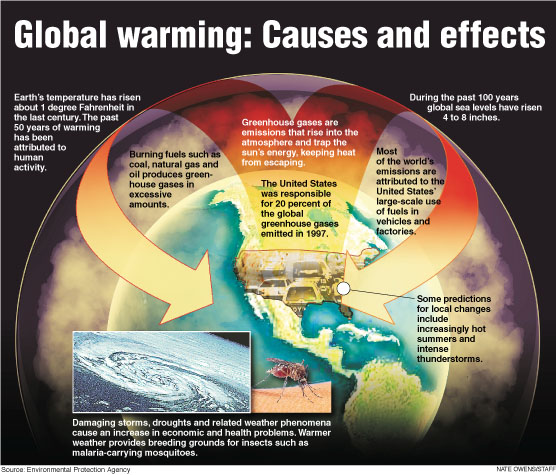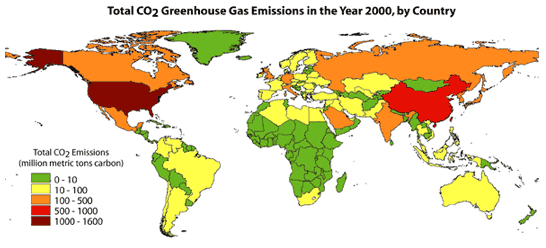Earth
Day
is April 22--where are we compared to 1970? What did
the
environmental movement of 1970-2005 accomplish?

- we've fixed what were identified as the worst problems
- chemical pollution problems are much less
- the endangered species act has worked
- remaining problems
are more
difficult
- after 1990 environmental ideas became increasingly global
- less consensus about
action
when problems are less severe and further in the future

The
hole
in the ozone layer
Backlash against the environmental movement on the grounds of personal property rights and local control
- larger pattern:
how a
problem is identified, political action is taken
(deciding on
regulation), solution put into place
- ground level ozone is a dangerous pollutant
- stratospheric ozone protects us from UV radiation
- in the upper atmosphere
ozone is constantly
being created and decaying
- certain chemicals, particularly CFCs used in air conditioning and aerosol cans, cause reactions that cause stratospheric ozone to decay faster
- hole in the ozone layer discovered by scientific experiments at the south pole and from satellites
- we got very quickly to
clear scientific
data about the problem
- if this had continued the ozone layer would have gotten thinner and thinner all over the earth
- if the ozone layer gets
thinner there will
be more skin cancer
- international agreements to stop producing those chemicals--1987 Montreal Protocol
- countries agreed to stop using CFCs
- this was easier to address because:
- the science was clear
- alternatives were
possible
- chemical engineers went out and found alternative chemicals (green chemistry)
- people did change their
behavior, stopped
using aerosol cans for many things
- this is working
- a much easier issue than global warming because there are easy substitutes
- we can invent a solution to the problem instead of having to change our behavior
- when this works it is great
- sometimes we hope for a technological fix because it is too hard to change people's behavior
- but often behavior has
to be addressed as
well
Backlash against the environmental movement on the grounds of personal property rights and local control
- if you own swampy land
near the
coast, you aren't allowed to drain and fill it to
build houses because
wetlands are protected
- the mainstream
big-government approach was
a paternalistic state--the government should protect
us
- trend
1990-2006--more
suspicion of government, more individualism, maybe
people have to
protect ourselves, questioning when the government
tries to make things
better does it really work?
- but there was
significant
reaction against the federal government telling
people what to do
- as in the Sagebrush Rebellion people tried to claim local control over federal land
- fight in Cantron county, New Mexico, about the owners of a small ranch who had permits to graze cattle on 145,000 acres of federal wilderness land
- more recently the issue has been property rights: should the government compensate you every time regulation limits what you can do with your property?
- if it did, regulation would be too expensive
- compromise--you can fill wetlands in one place if you restore an equal amount someplace else
- how much are
we willing
to accept limits on individualism and property
rights for the
collective good?
- the success of the environmental movement meant problems were less obvious and less pressing
- how bad do we
see the
problem to be, how much will it cost us to fix it,
how much will we
have to give up to fix it
- opinions became
more
polarized--people on both sides were less willing to
compromise
- hard case--the
problem did
not become clear quickly and the solution requires
changes in behavior,
there isn't an easy technological fix, the problem
is in the future
rather than immediate
- the industrial
revolution
led to burning of fossil fuels and increasing carbon
levels in the
atmosphere--increase in carbon dioxide from 280 to
375 ppm
- it is hard for us to believe we are affecting the whole world, not just our local area
- how to balance action globally?
- the third world will be hurt most
- is there a
technological
fix?
- nuclear power (expensive, some people are afraid of it)
- make cars and houses more efficient (maybe 10 or 20%)
- plant more trees (maybe 10%)
- what about a
more radical
approach
- pump carbon back into the ground--can this be done at a reasonable cost? Carbon sequestration requires the least change in what we do, but would be very expensive
- put sulfur dioxide in the upper atmosphere (artificial volcano)
- put mirrors in space to reflect sunlight away
- should we
consider such
geoengineering?
- there aren't easy substitutes; we may actually have to change our way of life
- people in the
developed
world use far more than our share of resources
- we can reduce energy use (this is actually the cheapest alternative), find sources of energy that don't produce carbon (hydro, wind, solar, nuclear) or remove carbon dioxide from the atmosphere
- pursue several
different
solutions at once--find 5 solutions each of which
reduce global warming
by 20%
- are we willing
to change
the way we do things to prevent these
problems? the next few
years will tell
- science cannot
give us sure
predictions

